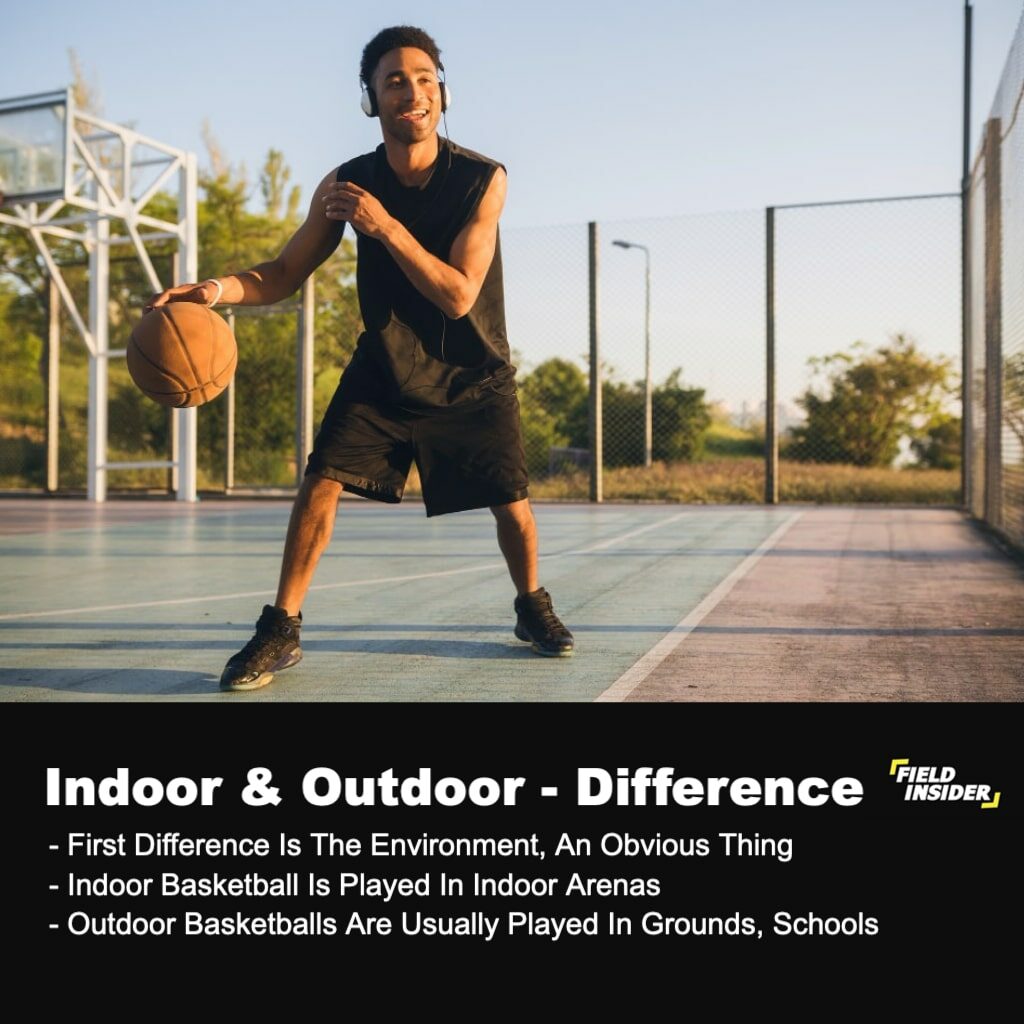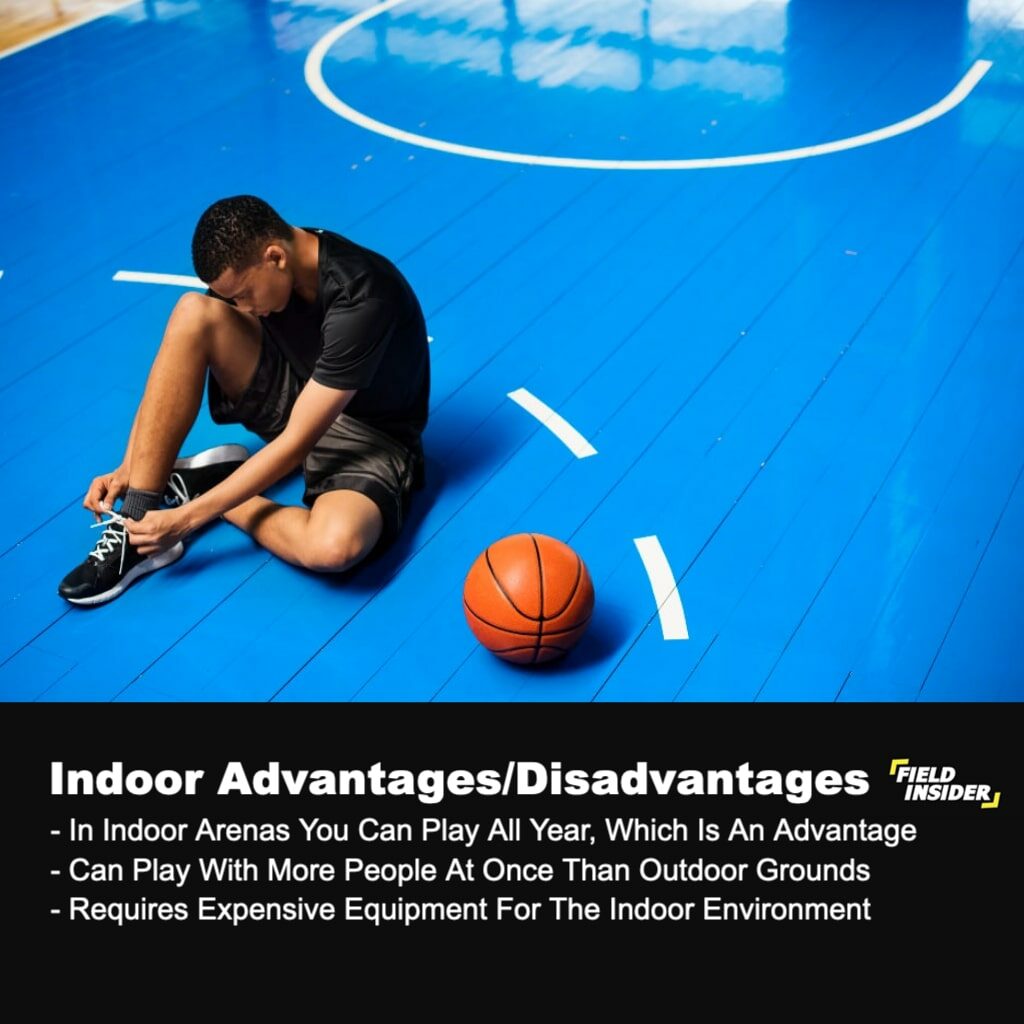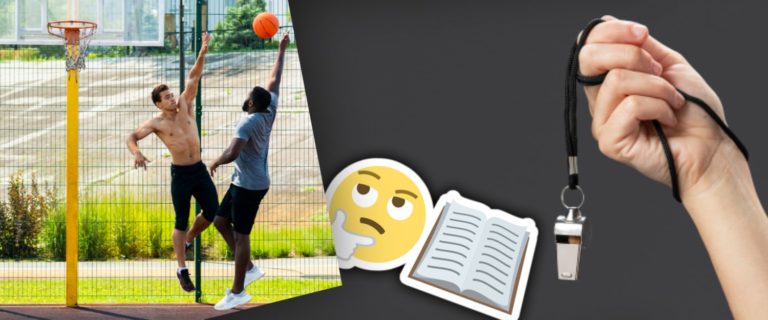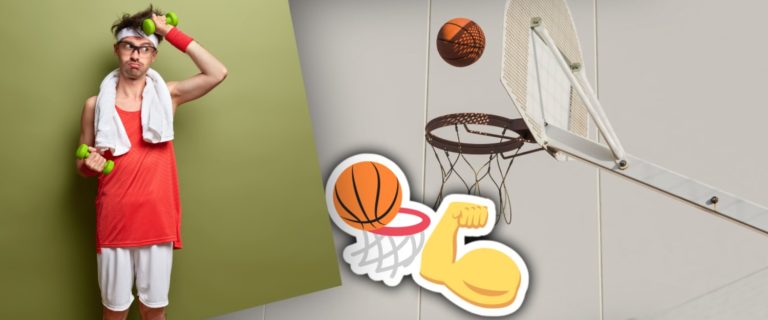Indoor vs. Outdoor Basketball Courts: Comparisons
What is the first thing that comes to mind when you think of indoor and outdoor basketball courts? What are the key distinctions between indoor and outdoor basketball courts? Which do you think is more popular in North America?
Both indoor and outdoor basketball courts have numerous advantages and disadvantages. In this blog post, we will look at some of these distinctions.
Also discussed is which type of court is more popular in North America. Continue reading to find out more!
Differences Between Indoor and Outdoor Basketball Courts
The Environment
The first and most obvious distinction between indoor and outdoor basketball courts is the setting in which they are played.
Indoor basketball courts are commonly found in sports arenas. Outdoor basketball courts can be found at schools, parks, and community centers.
Outdoor basketball courts typically have much more space. Because they are not restricted by walls like indoor basketball courts, this additional space can be useful for shooting drills or full-court games.
One disadvantage of outdoor basketball courts is that they are frequently windy, which can affect shot accuracy.
The Surface
Another significant distinction between indoor and outdoor basketball courts is the playing surface. Indoor surfaces are typically made of wood or hard plastic.
Outdoor surfaces can be constructed of concrete, asphalt, or even dirt. The surface on which you play has a significant impact on your playing experience.
For instance, if you are accustomed to playing indoor basketball and then transition to outdoor basketball. Because it is wetter, the outdoor court may be much more slippery.
Outdoor surfaces, on the other hand, have more traction than indoor surfaces, which can be useful if you’re playing on sand or grass.

The Lighting
The amount of lighting available is the final distinction between indoor and outdoor basketball courts.
Because they are indoors and do not receive natural light from windows or the sky, indoor basketball courts typically have much better lighting than outdoor courts.
Depending on your point of view, this can be an advantage or a disadvantage. If you’re used to playing on indoor courts, the lack of lighting on outdoor courts may make it difficult to play.
However, if you enjoy being outside and playing in the sun, outdoor basketball courts provide more daylight hours than indoor basketball courts.
Which is the Most Preferred Court Type?
Now that we’ve covered some of the differences between indoor and outdoor basketball courts let’s look at which is more popular in North America. In North America, indoor basketball courts are generally more popular than outdoor basketball courts.
This can be attributed to a number of factors, including weather (indoor basketball can be played in all types of weather), safety (outdoor basketball can often be played in less safe areas), indoor sports arenas, and the fact that indoor basketball is more convenient because it can be played all year.
Let us now discuss some of the benefits and drawbacks of both types of courts.
Indoor Basketball Courts: Advantages/Disadvantages

Advantages:
- play throughout the year (in an indoor sports arena)
- can play with a lot more people at once than outdoor courts, which usually only fit a half-dozen players on each side; this makes indoor court games easier for beginners or young children who might get lost when their team has over ten other players running around!
Disadvantage:
- To protect the court from damage, expensive equipment such as indoor basketball shoes with a non-marking rubber sole is required.
REASONS WHY PEOPLE LOVE indoor COURTS:
- Controlled Environment: Indoor basketball courts provide a controlled environment, free from the elements and other external factors that can affect the game, such as wind or rain. The controlled temperature and lighting also create a more consistent and comfortable playing experience.
- Accessibility: Many indoor basketball courts are located in gyms or community centers, making them more accessible to players regardless of the weather or time of day. This can make it easier for players to fit basketball into their schedules and make it a regular part of their fitness routine.
- Surface: Indoor basketball courts typically have a more consistent and uniform surface than outdoor courts, which can make it easier for players to move around and make plays. This can also reduce the risk of injuries.
- Equipment: Indoor basketball courts often have better equipment, such as high-quality basketballs, scoreboards, and sound systems. This can enhance the overall playing experience and make it more enjoyable for players.
- Privacy: Indoor basketball courts provide more privacy than outdoor courts, which can be an important consideration for players who value a more intimate playing experience. This can also create a sense of camaraderie and community among players who share the court.
Outdoor Basketball Courts: Advantages/Disadvantages

Advantages:
- larger than indoor courts
- can be played in all weather conditions (except rain)
- Indoor courts are generally less expensive to build and maintain.
Disadvantages:
- When wet, the surface can be slippery; this is especially true for outdoor courts made of concrete or asphalt.
- It is more difficult to find a place to play because there are fewer outdoor courts than indoor courts, especially in North America, where winters can be quite cold and snowy.
Reasons why people love outdoor courts:
- Fresh Air and Sunshine: Outdoor basketball courts provide an opportunity for players to enjoy fresh air and sunshine while playing the game they love. The natural surroundings and outdoor atmosphere can enhance the overall experience of playing basketball.
- Scenic Locations: Many outdoor basketball courts are located in beautiful locations, such as parks, beaches, and mountains. Playing on these courts can provide players with a scenic backdrop while they play the game.
- Open Space: Outdoor basketball courts often have more open space than indoor courts, which can make it easier for players to move around and make plays. The lack of walls and ceilings can also create a more open and fluid game.
- Community: Outdoor basketball courts are often located in public spaces and can attract a diverse group of players. This can create a sense of community and camaraderie among players, who may enjoy the opportunity to meet new people and make friends.
- Challenge: Playing on an outdoor basketball court can be more challenging than playing indoors, as players must contend with wind, uneven surfaces, and other outdoor elements. This can make the game more interesting and exciting for some players.
To summarize, while indoor basketball courts have some advantages over outdoor basketball courts, such as the ability to play in all weather conditions and more space, outdoor basketball courts also have their advantages.
These benefits include the ability to play in all weather conditions (except rain), being less expensive to build and maintain, and having a more natural feel because you are playing outside. It is ultimately up to the individual to choose which type of court they prefer!
What are Indoor Basketball Courts Made Of?
Indoor basketball courts are typically made of a hardwood surface, such as maple, which provides a consistent and durable playing surface. The hardwood is typically installed over a subfloor, which is designed to provide cushioning and prevent the hardwood from warping or shifting over time.
The subfloor may be made of a variety of materials, including concrete, asphalt, or synthetic materials like rubber or foam. Additionally, basketball courts may have painted lines and markings to designate the boundaries and various areas of the court.
What materials are used for outdoor courts?
Outdoor basketball courts can be made of a variety of materials, depending on the location and intended use of the court. Some common materials used for outdoor basketball courts include:
- Asphalt: Many outdoor basketball courts are made of asphalt, which is a durable and relatively inexpensive material. However, asphalt can be hard on the joints and may not provide the best traction for players.
- Concrete: Concrete is another common material used for outdoor basketball courts. It is more durable than asphalt and provides a smoother playing surface, but it can be more expensive to install.
- Rubber: Some outdoor basketball courts use rubber tiles or rolls, which provide cushioning and better traction than asphalt or concrete. However, rubber surfaces can be more expensive and may not be as durable as other materials.
- Plastic: Some outdoor basketball courts use interlocking plastic tiles, which are easy to install and provide good traction. However, plastic tiles may not be as durable as other materials and may be more prone to shifting or warping over time.
Is Practicing Basketball Indoor Better than Outdoors?
After discussing indoor and outdoor basketball courts, let’s move on to indoor versus outdoor practice.
Many people believe that practicing basketball indoors is easier because there are no distractions from the weather or bugs outside.
Indoor practice, on the other hand, is more expensive because you need a gymnasium with lighting as well as some type of ceiling or roof to protect against bad weather conditions such as rain.
Furthermore, due to limited floor space, indoor space can limit the number of players who can participate in practices at the same time!
When practicing outdoors, one advantage is that you can do so anywhere there is natural sunlight, rather than having an overbearing climate control system (such as air conditioning) blowing directly onto your face and body.
However, practicing outside is more difficult due to distractions such as bugs and inclement weather (especially rain).
Finally, indoor vs. outdoor basketball courts are a fascinating topic for anyone who enjoys the sport!
Whether you prefer indoor or outdoor courts, some advantages can help you excel in both indoor and outdoor practices and games!
What Happens if You Use an Indoor Basketball Ball Outside?
Outside practice, on the other hand, is more difficult due to distractions such as bugs and inclement weather (especially rain).
Finally, indoor vs. outdoor basketball courts are a fascinating topic for any basketball fan!
Whether you like playing on indoor or outdoor courts, the following benefits will help you do well in both practices and games.
So, even though you can technically bring your indoor ball outside if it’s raining or snowing, we don’t recommend using indoor balls on outdoor courts unless they are made for this.
Otherwise, when practicing outside, stick to outdoor-specific balls!
Conclusion
What are your thoughts? Which would you prefer to play on? Let us know what you think by leaving a comment below!
If you liked this post, please share it on social media so that others can learn more about indoor vs outdoor basketball courts!








